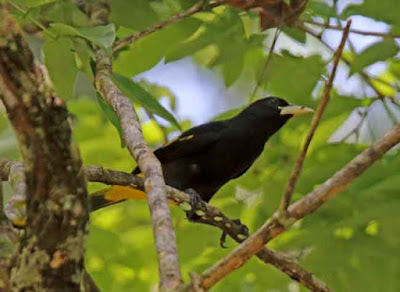I finally made it back to Colombia for my second visit and again used the guide services of Pablo Florez. I went with my friend Martin Jackson. We visited Inirida on the Orinoco, Santa Marta of course, Guajira Peninsula on the Caribbean coast, and a couple of National Parks around Bogota.
First a correction on the ID of Scaled Piculet on the previous bulletin. It is actually the Golden-spangled Piculet. Thanks to Pablo Florez for the correct ID.
Icterids are the New World blackbirds such as orioles, grackles and meadowlarks. Orioles are obviously the most colorful and we had 2 lifers for me - both on the Caribbean coast in extreme northeast Colombia.
The 8" Yellow Oriole (Icterus nigrogularis) was admiring his reflection in our vehicle window. He looks more orange than yellow to me but I am not the person who named the bird.
 |
| Yellow Oriole |
The other was the shy 8" Orange-crowned Oriole (Icterus auricapillus). He has more black than the first one - but the orange/yellow looks the same??
 |
| Orange-crowned Oriole |
 |
| Velvet-fronted Grackle |
The other is the 10.5" Carib Grackle (Quiscalus lugubris). It is similar to the Great-tailed Grackle but considerably smaller.
 |
| Carib Grackle |
Caciques are larger then orioles. Both the species we saw were not new for me. The 11" Yellow-rumped Cacique (Cacicus cela) is black with a yellow bill, rump and undertail.
 |
| Yellow-rumped Cacique |
The Solitary Cacique (Cacicus solitarius) is all black with a yellow bill.
 |
| Solitary Cacique |
 |
| Olive Oropendola |
The other was the 18" Crested Oropendola (Psarocolius decumanus). It is black with an ivory bill and yellow tail.
The last was a surprise for me to find the 9.5" Eastern Meadowlark (Sturnella magna) as a resident bird in mountains around Bogota. I had no idea that they had such an extensive range.
First is I always want to upgrade the photos. The Solitary Cacique here was much better than the other photo I had.
Second, is the possibility of the bird being split by subspecies in 2 or more species. If I have several photos from different locations, if a split occurs, I may already have the photos of both. The Eastern Meadowlark has 16 subspecies from eastern Canada to Brazil and Cuba.
I put the different bird/mammal families in single folders for easy viewing
David McDonald
dkmmdpa@gmail.com
photos copyright 2006 - 2021 David McDonald
To have these trip reports sent to your email, please email me at the above address and ask to subscribe.












